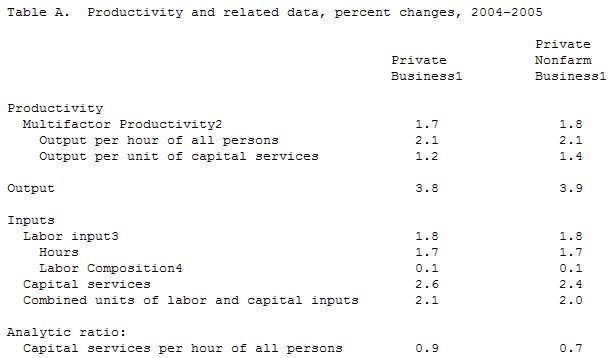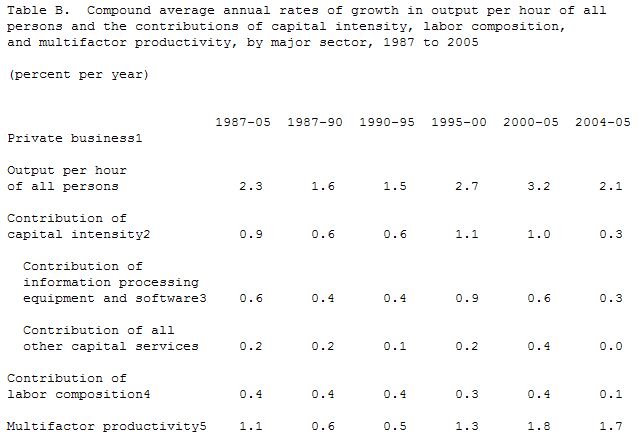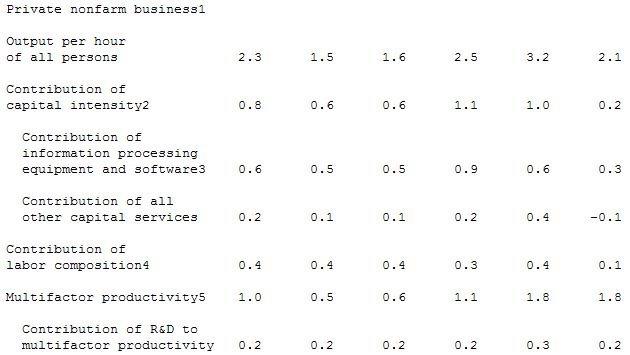2004-05
Private business sector 1.7
Private nonfarm business sector 1.8
Multifactor productivity in the private business and private nonfarm business sectors show a lower rate of growth than in the previous two years. The 1.7 percent change in multifactor productivity growth for the private business sector is just slightly lower than the preliminary 1.8 percent change reported on August 29, 2006 based on partial information.
Multifactor productivity is designed to measure the joint influences of economic growth on technological change, efficiency improvements, returns to scale, reallocation of resources, and other factors, allowing for the effects of capital and labor. Multifactor productivity, therefore, differs from labor productivity (output per hour worked) measures that are published quarterly by BLS since it includes information on capital services and other data that are not available on a quarterly basis.
In private business and private nonfarm business, the change in multifactor productivity reflects the difference between the change in real gross domestic product for the sector and the change in labor and capital inputs engaged in the production of this output. The output measures for private business and private nonfarm business are similar to the indexes of output for business and nonfarm business used in the quarterly labor productivity measures differing in that the output of government enterprises is omitted.
A change in multifactor productivity reflects the change in output that cannot be accounted for by the change in combined inputs of labor and capital. In contrast, a change in labor productivity reflects the change in output that cannot be accounted for by the change in hours of all persons engaged in production.
Private business sector
Over the last 18 years, capital services have grown more rapidly than hours in the private business sector, and the skills of workers - as measured by their education and work experience - also have risen over this period. These shifts toward more capital intensive production and toward workers with more human capital have supplemented labor productivity growth, usually allowing output per hour to grow at a faster rate than multifactor productivity.
Multifactor productivity rose 1.7 percent in 2005, a slower rate of growth than in 2003 and 2004. The multifactor productivity gain in 2005 reflected a 3.8 percent increase in output and a 2.1 percent increase in the combined inputs of capital and labor.
Continuing the relatively slow growth of the last four years, growth in capital services rose 2.6 percent. However, labor input rose 1.8 percent, slightly higher than the 1.5 percent increase of 2004. Hours rose 1.7 percent. The capital-labor ratio (capital services per hour of all persons) increased by 0.9 percent.
Equipment capital services grew 4.0 percent in 2005, much more rapidly than other broad categories of capital assets. Within equipment, services of computers and related equipment grew 13.3 percent, software 6.2 percent, communication equipment 5.1 percent, other information processing equipment 3.7 percent, and all other equipment 2.0 percent. All rates of increase are markedly lower than in the 1995-2000 period except for other information processing equipment. Services of structures grew 0.9 percent in 2005, as compared to a compound average rate of 2.0 percent over the 1995-2000 period. Inventories grew at an annual rate of 2.8 percent in 2005, down from the 4.3 percent compound average annual rate of growth in the 1995-2000 period.


Labor input reflects the change in hours at work adjusted for the effects of changing labor composition. As mentioned previously, labor input rose 1.8 percent. This modest increase in labor input was due to an increase in hours at work of 1.7 percent and a modest contribution from labor composition. Changes in labor composition, as measured by shifts in the educational attainment and work experience of the work force, rose only 0.1 percent.
Labor productivity (output per hour worked) increased 2.1 percent, the fourth consecutive year in which the growth rate of labor productivity decelerated. Capital productivity (output per unit of capital services) grew 1.2 percent, the third consecutive annual increase.
Private nonfarm business sector
Multifactor productivity in the private nonfarm business sector rose 1.8 percent in 2005, lower than the 2.6 percent increase in 2004. Output
increased 3.9 percent, and the combined inputs of capital and labor increased 2.0 percent.
Labor input and capital services grew slightly higher in 2005 than the previous year. Labor input grew 1.8 percent, compared to 1.6 percent in 2004.
Capital services grew 2.4 percent, compared to 2.2 percent in 2004. Within capital services, equipment was the fastest growing component.
The increase in equipment in 2005 was largely due to capital services of information processing equipment and software rising by 6.7 percent. As in previous years, the fastest growth in equipment was in computers and related equipment, which grew 13.3 percent.
Labor productivity grew 2.1 percent and capital productivity rose 1.4 percent. Capital services per hour increased at the rate of 0.7 percent.
Historical trends in the private business and private nonfarm business sectors
Labor productivity (output per hour worked) differs from multifactor productivity (output per unit of combined capital and labor inputs) in the treatment of both capital and hours. Labor productivity measures do not explicitly account for the effects of capital nor do they account for changes in the composition of labor on output growth. As a result, changes in capital intensity (the capital-hours ratio) and labor composition can influence labor productivity growth. In contrast, multifactor productivity treats capital as an explicit factor of production and, therefore, is net of changes in capital intensity. In addition, the labor input measure used to calculate multifactor productivity reflects the combined effects of changes in hours at work and of shifts in the educational attainment and experience of the work force. Therefore, multifactor productivity accounts for changes in labor composition as well. Historical trends in labor productivity growth can be viewed as the sum of three components: multifactor productivity growth, the contribution of increased capital intensity, and the contribution of shifts in labor composition. The relationship between labor productivity growth and these three components can be seen in table B.
The contribution of capital intensity equals the change in the capital-hours ratio multiplied by capital's share of total payments to inputs. The contribution of labor composition equals the difference between the growth rate of labor input and the growth rate of hours multiplied by labor's share of total payments. Historically, capital's share has been slightly less than a third of total payments.
Because trends in the private nonfarm business sector were similar to those in the private business sector in each period, the description that follows focuses exclusively on the private business sector.
Over the 1987-2005 period, output per hour worked grew at an annual rate of 2.3 percent in private business. Of the 2.3 percent growth rate in labor productivity, 1.1 percent can be attributed to increases in multifactor productivity, 0.9 percent to the contribution of capital intensity, and 0.4 percent to changes in labor composition. Since 1987, output per hour worked has accelerated, growing 1.5 percent in the 1990-95 period, 2.7 percent in the 1995-2000 period, and 3.2 percent in the 2000-2005 period.
In the period 1987-1990, all of the productivity measures (see table B) grew to varying degrees. Multifactor productivity increased at annual average rate of 0.6 percent. Labor productivity grew at annual average rate of 1.6 percent. The contribution of capital intensity averaged a growth rate of 0.6 percent, with information processing equipment exhibiting a growth rate of 0.4 percent and other capital services growing 0.2 percent. The contribution of labor composition increased 0.4 percent.
Over the 1990-1995 period, increases in the productivity measures were similar to those in the 1987-1990 period. Multifactor productivity rose 0.5 percent. Labor productivity grew at 1.5 percent. The contribution of capital intensity grew 0.6 percent, with information processing equipment contributing two-thirds of this growth. The contribution of labor composition rose 0.4 percent, the same as in the previous period.
In the latter half of the 1990s, productivity growth accelerated. Multifactor productivity growth increased 1.3 percent, and output per hour growth nearly doubled compared to the 1990-95 period, rising 2.7 percent. The contribution of capital intensity almost doubled from the 1990-95 period, rising an average of 1.1 percent. The growth in each of the two components of the contribution of capital intensity, information processing equipment and other capital services, doubled from the previous period, with information processing equipment commanding an even more predominant share of the total contribution of capital services. The growth of the contribution of information processing equipment rose to 0.9 percent, while the contribution of other capital services grew 0.2 percent. The contribution of labor composition dropped 0.1 percentage point from the previous period, to 0.3 percent.
In the 2000-2005 period, multifactor productivity growth increased an additional 0.5 percentage points from the 1995-2000 period, to 1.8 percent. Labor productivity continued its upward trend, rising an average of 3.2 percent per year. The contribution of capital intensity growth dropped 0.1 percentage points from the previous period to 1.0 percent. Growth in the composition of capital intensity came in equal parts from both of the major components. The contribution of information processing equipment dropped to a growth rate of 0.6 percent from 0.9 percent in the 1995-2000 period. At the same time, the contribution of other capital services rose to 0.4 percent. The contribution of labor composition growth increased to 0.4 percent.



While multifactor productivity reflects many influences, technological change is one of the primary contributors. For the private nonfarm business sector, BLS also reports estimates of the impact on multifactor productivity growth of firms' spending for research and development (R&D) on all firms within the same industries. Because many people associate research and development spending and the resulting technological improvements with productivity, multifactor productivity has not been adjusted to exclude the effects of research and development. The contribution of research and development averaged 0.2 percent per year for the entire 1987-2005 period, or about 20 percent of total multifactor productivity growth (see table B). The contribution of research and development varied little over time, contributing 0.2 percent per year during the following periods: 1987-90, 1990-95, and 1995-2000. The contribution of research and development to multifactor productivity increased to 0.3 percent in the 2000-05 period.





